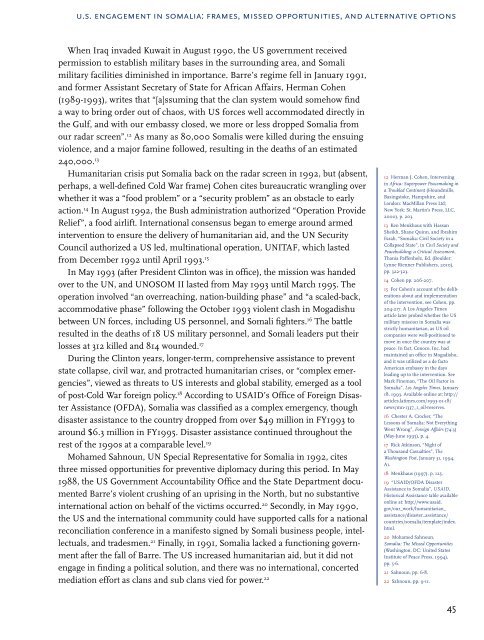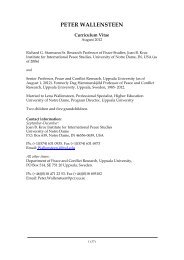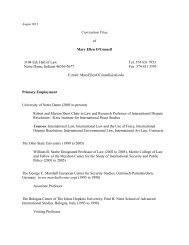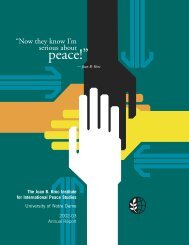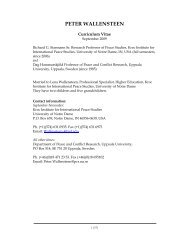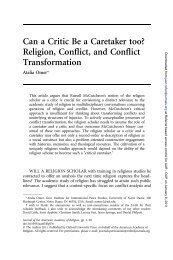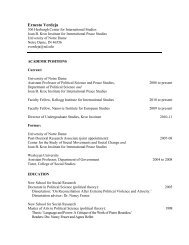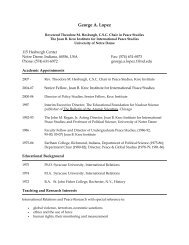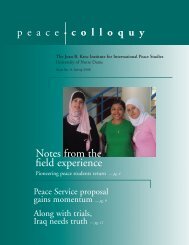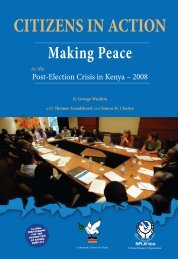Somalia: Creating Space for Fresh Approaches to Peacebuilding
Somalia: Creating Space for Fresh Approaches to Peacebuilding
Somalia: Creating Space for Fresh Approaches to Peacebuilding
Create successful ePaper yourself
Turn your PDF publications into a flip-book with our unique Google optimized e-Paper software.
u.s. engagement in somalia: frames, missed opportunities, and alternative options<br />
When Iraq invaded Kuwait in August 1990, the US government received<br />
permission <strong>to</strong> establish military bases in the surrounding area, and Somali<br />
military facilities diminished in importance. Barre’s regime fell in January 1991,<br />
and <strong>for</strong>mer Assistant Secretary of State <strong>for</strong> African Affairs, Herman Cohen<br />
(1989-1993), writes that “[a]ssuming that the clan system would somehow find<br />
a way <strong>to</strong> bring order out of chaos, with US <strong>for</strong>ces well accommodated directly in<br />
the Gulf, and with our embassy closed, we more or less dropped <strong>Somalia</strong> from<br />
our radar screen”. 12 As many as 80,000 Somalis were killed during the ensuing<br />
violence, and a major famine followed, resulting in the deaths of an estimated<br />
240,000. 13<br />
Humanitarian crisis put <strong>Somalia</strong> back on the radar screen in 1992, but (absent,<br />
perhaps, a well-defined Cold War frame) Cohen cites bureaucratic wrangling over<br />
whether it was a “food problem” or a “security problem” as an obstacle <strong>to</strong> early<br />
action. 14 In August 1992, the Bush administration authorized “Operation Provide<br />
Relief”, a food airlift. International consensus began <strong>to</strong> emerge around armed<br />
intervention <strong>to</strong> ensure the delivery of humanitarian aid, and the UN Security<br />
Council authorized a US led, multinational operation, UNITAF, which lasted<br />
from December 1992 until April 1993. 15<br />
In May 1993 (after President Clin<strong>to</strong>n was in office), the mission was handed<br />
over <strong>to</strong> the UN, and UNOSOM II lasted from May 1993 until March 1995. The<br />
operation involved “an overreaching, nation-building phase” and “a scaled-back,<br />
accommodative phase” following the Oc<strong>to</strong>ber 1993 violent clash in Mogadishu<br />
between UN <strong>for</strong>ces, including US personnel, and Somali fighters. 16 The battle<br />
resulted in the deaths of 18 US military personnel, and Somali leaders put their<br />
losses at 312 killed and 814 wounded. 17<br />
During the Clin<strong>to</strong>n years, longer-term, comprehensive assistance <strong>to</strong> prevent<br />
state collapse, civil war, and protracted humanitarian crises, or “complex emergencies”,<br />
viewed as threats <strong>to</strong> US interests and global stability, emerged as a <strong>to</strong>ol<br />
of post-Cold War <strong>for</strong>eign policy. 18 According <strong>to</strong> USAID’s Office of Foreign Disaster<br />
Assistance (OFDA), <strong>Somalia</strong> was classified as a complex emergency, though<br />
disaster assistance <strong>to</strong> the country dropped from over $49 million in FY1993 <strong>to</strong><br />
around $6.3 million in FY1995. Disaster assistance continued throughout the<br />
rest of the 1990s at a comparable level. 19<br />
Mohamed Sahnoun, UN Special Representative <strong>for</strong> <strong>Somalia</strong> in 1992, cites<br />
three missed opportunities <strong>for</strong> preventive diplomacy during this period. In May<br />
1988, the US Government Accountability Office and the State Department documented<br />
Barre’s violent crushing of an uprising in the North, but no substantive<br />
international action on behalf of the victims occurred. 20 Secondly, in May 1990,<br />
the US and the international community could have supported calls <strong>for</strong> a national<br />
reconciliation conference in a manifes<strong>to</strong> signed by Somali business people, intellectuals,<br />
and tradesmen. 21 Finally, in 1991, <strong>Somalia</strong> lacked a functioning government<br />
after the fall of Barre. The US increased humanitarian aid, but it did not<br />
engage in finding a political solution, and there was no international, concerted<br />
mediation ef<strong>for</strong>t as clans and sub clans vied <strong>for</strong> power. 22<br />
12 Herman J. Cohen, Intervening<br />
in Africa: Superpower Peacemaking in<br />
a Troubled Continent (Houndmills,<br />
Basings<strong>to</strong>ke, Hampshire, and<br />
London: MacMillan Press Ltd;<br />
New York: St. Martin’s Press, LLC,<br />
2000), p. 203.<br />
13 Ken Menkhaus with Hassan<br />
Sheikh, Shane Quinn, and Ibrahim<br />
Farah, “<strong>Somalia</strong>: Civil Society in a<br />
Collapsed State”, in Civil Society and<br />
<strong>Peacebuilding</strong>: a Critical Assessment,<br />
Thania Paffenholz, Ed. (Boulder:<br />
Lynne Rienner Publishers, 2010),<br />
pp. 322-323.<br />
14 Cohen pp. 206-207.<br />
15 For Cohen’s account of the deliberations<br />
about and implementation<br />
of the intervention, see Cohen, pp.<br />
204-217. A Los Angeles Times<br />
article later probed whether the US<br />
military mission in <strong>Somalia</strong> was<br />
strictly humanitarian, as US oil<br />
companies were well-positioned <strong>to</strong><br />
move in once the country was at<br />
peace. In fact, Conoco, Inc. had<br />
maintained an office in Mogadishu,<br />
and it was utilized as a de fac<strong>to</strong><br />
American embassy in the days<br />
leading up <strong>to</strong> the intervention. See<br />
Mark Fineman, “The Oil Fac<strong>to</strong>r in<br />
<strong>Somalia</strong>”, Los Angeles Times, January<br />
18, 1993. Available online at: http://<br />
articles.latimes.com/1993-01-18/<br />
news/mn-1337_1_oil-reserves.<br />
16 Chester A. Crocker, “The<br />
Lessons of <strong>Somalia</strong>: Not Everything<br />
Went Wrong”, Foreign Affairs (74:3)<br />
(May-June 1995), p. 4.<br />
17 Rick Atkinson, “Night of<br />
a Thousand Casualties”, The<br />
Washing<strong>to</strong>n Post, January 31, 1994,<br />
A1.<br />
18 Menkhaus (1997), p. 125.<br />
19 “USAID/OFDA Disaster<br />
Assistance <strong>to</strong> <strong>Somalia</strong>”, USAID,<br />
His<strong>to</strong>rical Assistance table available<br />
online at: http://www.usaid.<br />
gov/our_work/humanitarian_<br />
assistance/disaster_assistance/<br />
countries/somalia/template/index.<br />
html.<br />
20 Mohamed Sahnoun,<br />
<strong>Somalia</strong>: The Missed Opportunities<br />
(Washing<strong>to</strong>n, DC: United States<br />
Institute of Peace Press, 1994),<br />
pp. 5-6.<br />
21 Sahnoun, pp. 6-8.<br />
22 Sahnoun, pp. 9-11.<br />
45


